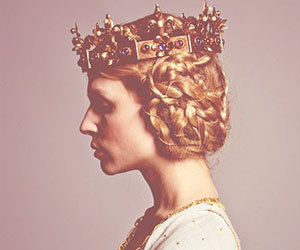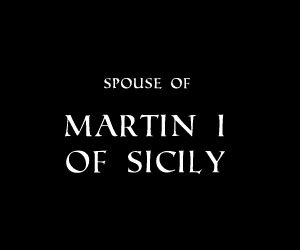gardenofkore: Maria was born in Catania on July 2nd 1363. Her father was Frederick III (or IV)
gardenofkore: Maria was born in Catania on July 2nd 1363. Her father was Frederick III (or IV) the Simple, King of Trinacria and Duke of Athens and Neopatras. Her mother, Constance of Aragon (firstborn of Peter IV King of Aragon and his first wife Maria of Navarre) died in childbirth. After Constance’s death, Frederick married Antonia of Baux, sister of the last Latin Emperor of Constantinople James of Baux. Antonia died childless in 1374 after only two years of marriage. Frederick never remarried and when he died in 1377 his sole legitimate heir was his 14 old daughter, Maria, notwithstanding the provisions of Frederick II (III) which forbidden female heirs to succeed. In his will, Frederick III arranged that in case Maria would have died without heirs, the crown would have passed to the House of Aragon. To his bastard son William, Frederick left the islands of Malta and Gozo. Because of her young age, but mainly since she was female, Maria wasn’t free to rule by herself. Her godfather and legal guardian, Artale I Alagona earl of Mistretta and Lord of Paternò, assumed the regency but was soon forced to form a government with three other Vicars whom belonged to the most influential families (Francesco II Ventimiglia earl of Geraci, Manfredi III Chiaramonte earl of Modica and Guglielmo Peralta earl of Caltabellotta). The main purpose of this council would have been to ensure good governance and balance between the Latin faction and the rival Catalan faction. De facto each one of the four noblemen ruled over a part of the island, while Maria was queen in name only and lived in semi-liberty in Castello Ursino in Catania, under the protection of her godfather. When it came the time to find her a husband, Artale planned to marry the young queen to the duke of Milan, Gian Galeazzo Visconti. The Vicar’s hidden plan was to rule over all Sicily once his goddaughter would have left the island to live with her husband. Unfortunately for him, on the night of January 23rd 1379 Maria was kidnapped by Guglielmo Raimondo Moncada earl of Agosta. Moncada was supported by Peter IV of Aragon, who was against the Milanese marriage plan since he would have lost his claims over Sicily if his granddaughter were to marry the Duke Visconti. The King of Aragon took charge of the government of the Kingdom of Trinacria and sent his son Martin the Older Duke of Montblanc to Sicily to act as a Viceroy. Martin was not only Maria’s uncle, but was also her first cousin since Martin’s mother was Eleanor of Sicily, Frederick III’s older sister. Maria was escorted to the castle of Augusta (modern-day province of Siracusa), but soon the castle was put under siege by Artale of Alagona who intended to retrieve his goddaughter. Maria was then moved to the castle of Licata. In the meantime Peter IV arranged the marriage of the queen with another one of his grandsons, Martin the Younger. The marriage contract was signed on July 24th 1380 by the King of Aragon, the groom’s father Martin the Older, Guglielmo Raimondo Moncada and Enrico Rosso earl of Aidone. Since the Artale wouldn’t give up, Maria was sent to Sardinia and later to Barcelona. In 1388 she was moved to Terrasa because at that moment Barcelona was striken by plague. Since leaving Sicily, she never lived according to her status but in isolation and tight budget. Under the regency of her grandfather, Maria lost the duchies of Athene and Neopatras. After being run by the Aragonese, in 1381 the Florentine aristocrat Nerio Acciaioli occupied Athens and in 1390 Neopatras. In 1387 Peter IV died and was succeeded by his son John I. Like his younger brother, Martin the Older, John was the son of Peter IV and Eleanor of Sicily. In 1391 in Barcelona Maria finally married her cousin Martin, who would have ruled along with his wife as Martin I. Since the bride and groom were blood relatives, the needed a papal dispensation. The approval was granted by Antipope Clemens VII, whom the House of Aragon decided to support during the matter of the Papal Schism. In the eyes of the Sicilian nobles Martin was seen as a usurper. On July 10th 1391, the four Vicars met in the Church of St. Peter in Castronovo di Sicilia (modern-day province of Palermo) and pledged their loyalty to the queen, but rejected Martin. A similar oath was taken at the beginning of the same year in the castle of Mussomeli, property of the Chiaramonte family. They were backed by Pope Boniface IX who entrusted them of the rule of the island. The Vicars also appealed for the help of King Ladislaus of Naples and Gian Galeazzo Visconti of Milan. Surprisingly this oath was short-lived since Ventimiglia, Alagona and Peralta would later welcome with open arms the queen and her husband. On March 22nd 1390, Maria along with her husband and father-in-law landed in the island of Favignana (near Trapani) and then proceeded to Palermo, which was conquered. Maria and Martin were finally crowned in Palermo’s Cathedral and after putting to death the rebel Andrea Chiaramonte (successor of Manfredi III), they continued their campaign to re-conquer Sicily. They freed Catania, then Messina and had to go back to Catania which was occupied once again by the rebels. Maria chose to settle in the Castello Ursino, which once had been her first gilded cage. In 1396 John I of Aragon died and Martin the Older had to go back to Spain to succeed his brother. The departure of her father-in-law stressed so much Maria to the point she fell into depression and became ill. She would be treated by many physicians (among them Josef Abenafia) and being poor of health for a whole year. On November 17th 1398, two and half in the morning, the queen gave birth to her only son and heir. Despite his mother chose for the baby the name Frederick (after his maternal grandfather), the baby was christened as Peter, to honour King Peter IV, on April 23rd 1399. Maria’s happiness wouldn’t last long. On November 8th 1400 Peter was accidentally hit by a spear during a tournament and died, causing the queen to fall into despair. When Catania was stricken by the plague, it was disposed to transfer Maria to a safer place. The measure proved to be ineffective since Maria caught the plague and died (alone as she had lived) in the castle of Lentini (modern-day province of Siracusa) on May 25th 1401. She was buried in Catania’s Cathedral, the same place where her mother and son rested. At the news of her death, her father-in-law ordered that every court, cathedral and city of Aragon should commemorate the late queen. After Maria’s death, her husband Martin I became the only sovereign and the year after married Blanche of Navarre. -- source link









